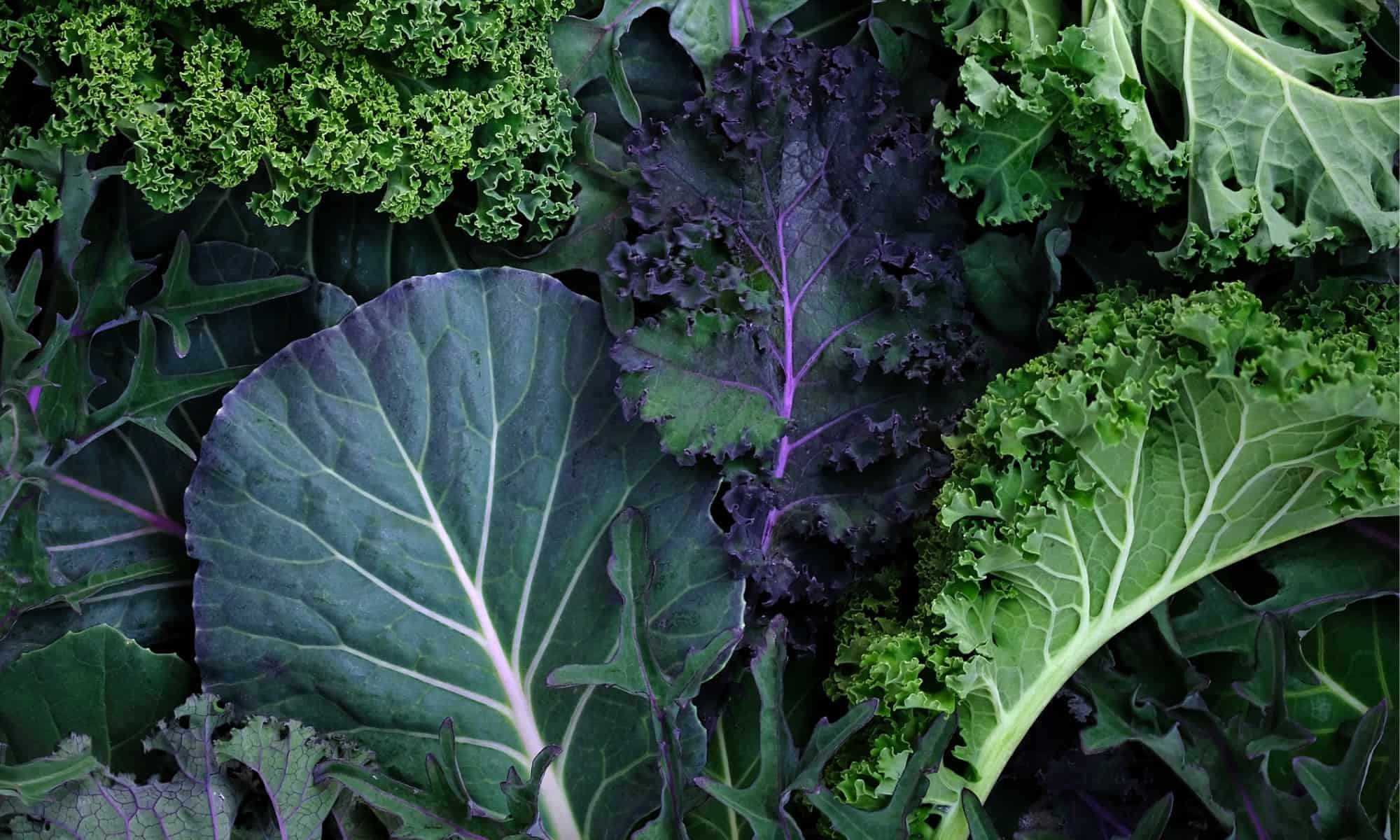There are a good number of foods that start with K. They’re a diverse bunch and range from a green leafy vegetable to a type of bean to a fruit with a fuzzy skin to organ meat. Learn about these 10 types of foods whose names start with K.
1. Kale
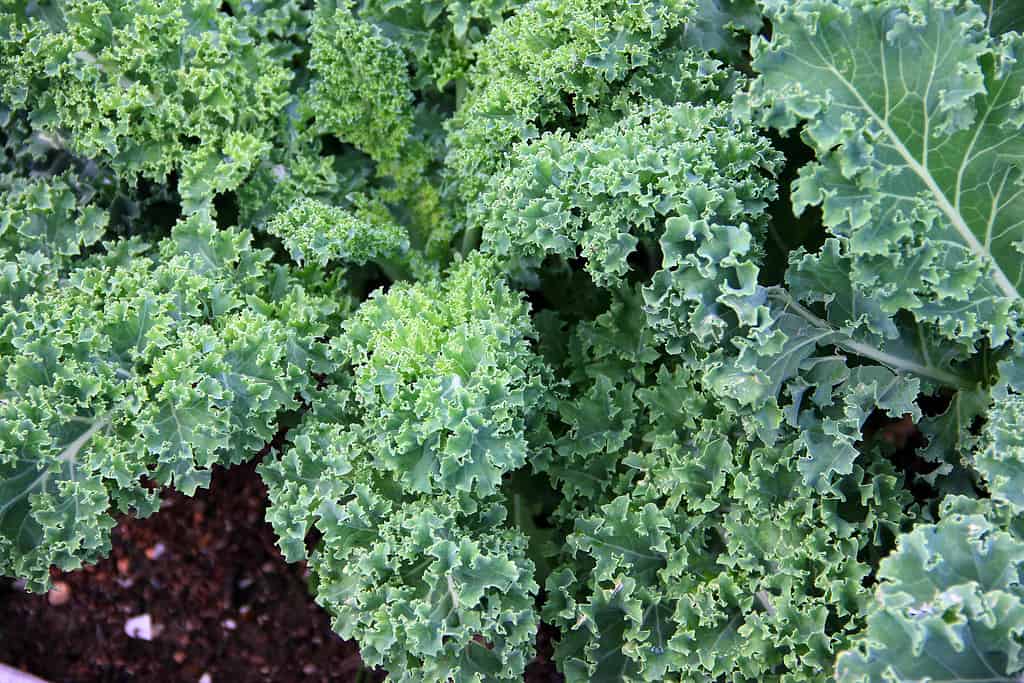
Kale is a nutritious, cool-season vegetable.
©/ via Getty Images
This green leafy vegetable belongs to the Brassica species. People have been enjoying this veggie since at least 2000 BC. There are both curly and flat-leaved varieties, and they are not even all green. Some types of kale are violet, green or violet, brown. Ornamental kale comes in colors of lavender blue, violet, white, pink, or red. It too is edible but doesn’t taste as good as kale grown for the table.
Kale plants don’t form a head, and the way to harvest garden plants is to pick the leaves off of the stem. Gardening experts recommend plucking the middle leaves, which may leave a plant looking rather like a palm tree.
This food that starts with K is an annual, though it can last a surprisingly long time in the garden. Kale does well in cool weather. It not only tolerates temperatures as low as 5 degrees Fahrenheit but is sweeter after it’s touched by a bit of frost.
Kale is abundant in a variety of nutrients, including Vitamin K, Vitamin A, Vitamin C, and manganese. It’s also rich in carotenoids and other phytochemicals. It’s boiled, used in stir-fries, baked in casseroles, cooked slowly, or microwaved until it turns into a delicious chip.
2. Kohlrabi
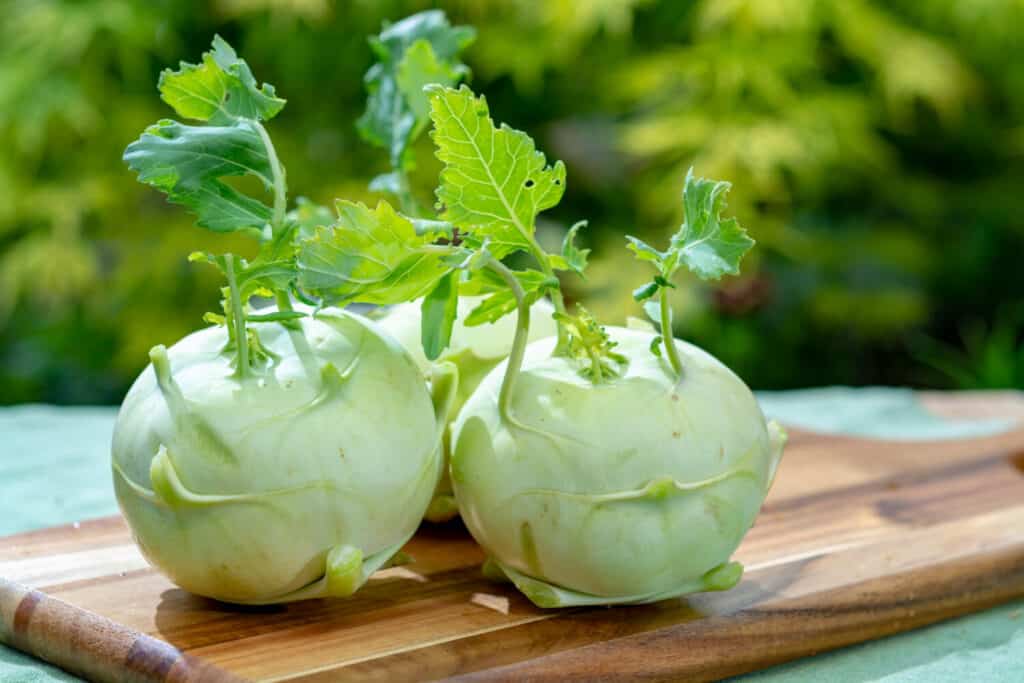
Kohlrabi has been bred to have a bulbous stem and a taste like mild cabbage heart.
©barmalini/Shutterstock.com
A half-sibling of kale, this food that starts with K is a biennial. Its name comes from the German words for cabbage and turnip because the stem is globular and resembles a turnip. Both this stem and the leaves are edible, and kohlrabi is enjoyed cooked or raw. The taste is said to be between the heart of a cabbage or the stem of broccoli though sweeter and crisper. Kohlrabi shouldn’t be eaten if it’s too much more than 4 inches around. If the vegetable is much larger than that, it’ll probably be woody.
Kohlrabi is high in nutrients, especially carbohydrates, dietary fiber, Vitamin B6, and Vitamin C. The rounded stem is covered with tough layers that need to be peeled away before cooking. Enjoy kohlrabi in salads, stews, stir-fries, and relishes.
3. Kumquat

Eat kumquats whole: peel, pulp, seeds, and all.
©iStock.com/bergamont
Another of the foods that start with K, the kumquat is a tiny citrus fruit that comes from Southern China and has been enjoyed there since at 12th century if not earlier. The taxonomy of the fruit is tangled, but there are several varietals such as the Hong Kong kumquat, the Meiwa kumquat, the oval, or Nagami kumquat, and the Malayan kumquat. The kumquat is also crossed with other citruses such as Mandarin oranges, key limes, and Meyer lemons.
The tree that produces the kumquat is much tougher than the trees that bear lemons and oranges. It can tolerate great heat and great cold as long as it gets direct sunlight. Growing kumquats from seeds is uncertain, so it’s best to grow them using rootstock or cuttings. Like a lot of citrus fruits, kumquats are rich in vitamin C. They are small enough to be eaten whole after being rolled between the hands for a few moments.
4. Kimchi
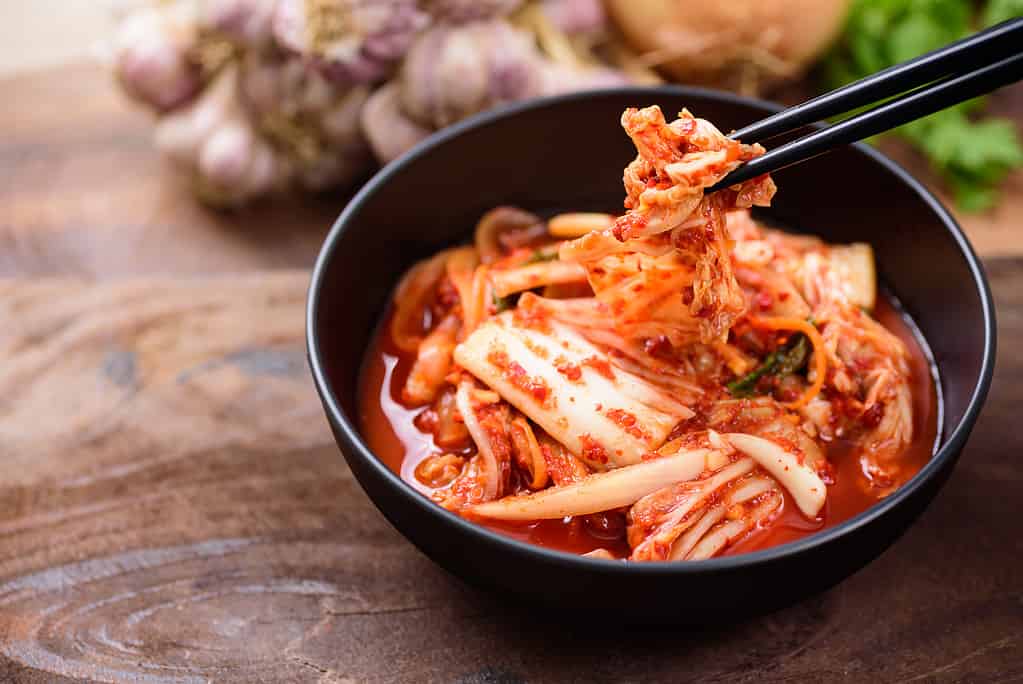
Kimchi is made of fermented vegetables and is a popular dish in
Korea
.
©Nungning20/Shutterstock.com
You’ll enjoy this Korean dish made of fermented and seasoned vegetables with a helping of rice. The vegetables are usually napa cabbage or a white Korean radish called mu. Other vegetables used in kimchi include celery, cucumbers, Korean parsley, and lotus root. The seasonings can be very diverse and can include ginger, garlic, scallions, fish sauce, and chili powder. Kimchi is also added to stews and soups. There is an adage that every family has its own recipe for kimchi. For many, the spiciness and earthiness of good kimchi tastes like home.
5. Kidney Beans

Kidney beans aren’t only red but can be speckled and white.
©Satit Pecharut/Shutterstock.com
A member of the Phaeolus genus to which most common beans belong, this bean was given its name because it looks like a kidney. Not all kidney beans are red, however. There are also kidney beans that are speckled in white, speckled in red, and even mostly white. Like most beans, kidney beans are rich in fiber and low in fat. They’re also a good source of carbohydrates, folate, iron, and phosphorus.
Kidney beans are featured in popular dishes all around the world and are found in soups and stews. They’re also soaked overnight, then boiled and seasoned. Sometimes, cooked kidney beans are pounded into bean paste and used in such dishes as refried beans. It’s important to soak red and white kidney beans before cooling them because they have high levels of phytohemagglutinin. This is a toxin that makes red blood cells stick together and causes nausea, vomiting, and diarrhea. It’s a good idea to soak the beans overnight in water and then boil them for 10 to 30 minutes.
6. Real Kidneys

Steak and kidney pie is a popular dish in England.
©Sean Whitton (User:Xyrael), CC BY-SA 3.0 – Original / License
Kidneys are commonly eaten organ meats, or offal. People eat the kidneys of cows, calves, pigs, lamb, and chickens, though chicken kidneys are so small they’re hardly worth preparing and cooking. Kidneys are fried, grilled, braised, roasted, or stewed. The rule of thumb is that kidneys should be used soon after buying or used right away after they’ve been defrosted. Kidneys are rich in protein, B vitamins, iron, zinc, phosphorus, and Vitamin A.
Wherever the kidney comes from, it should be firm and have a sweet smell. To prepare it, take off the surrounding fat and skin, cut it in half, and take out the tough core. Depending on the animal, kidneys can have a mild or strong flavor. The strong flavor of beef kidney, for example, makes it great for steak and kidney pies. Given the kidneys’ function, expect them to also have, as James Joyce writes in Ulysses “a fine tang of faintly scented urine.”
7. Kelp
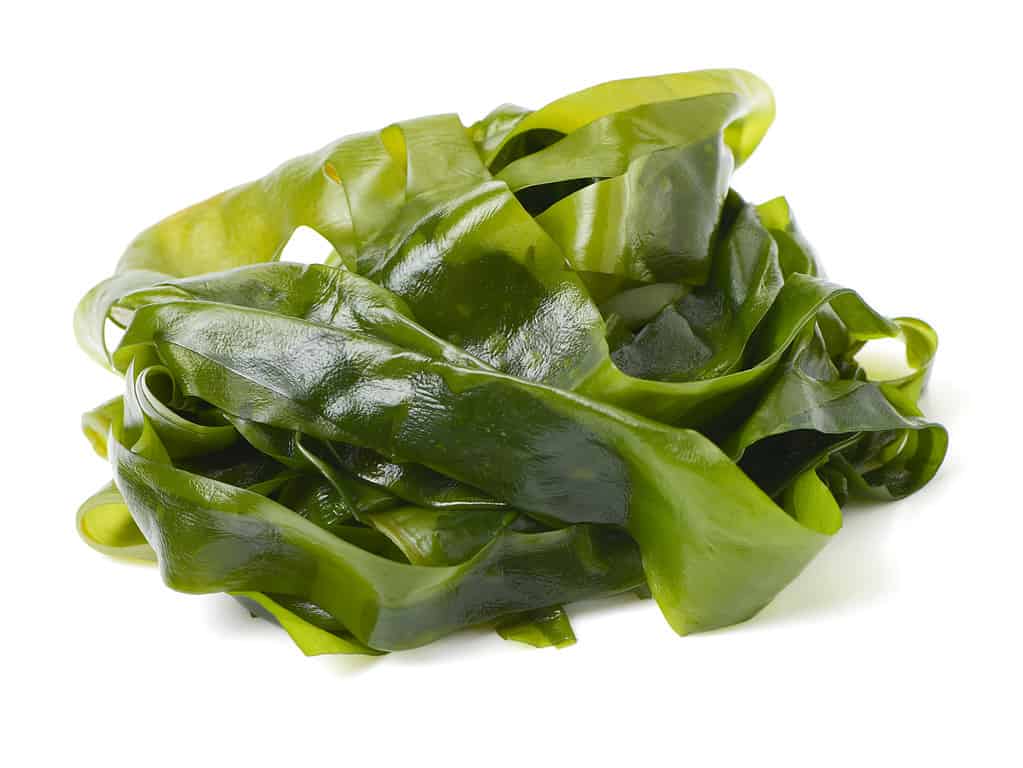
Kombu can be cooked and eaten as a vegetable.
©iStock.com/chengyuzheng
Kelp is a type of seaweed, but not all seaweed is kelp. This sea vegetable is the larger type of seaweed and is called kombu in Japan. Kombu has been eaten for over 1,500 years and is used, along with shaved bonito flakes, to make dashi, a delicate broth. It’s also used for seasoning and in soups. Another form of kelp called laver is used to make laverbread. This bread is eaten in the British Isles. Kelp is also used in dishes prepared with tofu or simply cooked and eaten by itself as a vegetable. Kelp, or kombu is very high in iodine, fiber, and glutamic acid.
8. Kefir

Cow, goat, or sheep’s milk is used to make kefir.
©Chatham172/Shutterstock.com
Kefir is much like yogurt in that it’s made of fermented milk. In the case of kefir, the drink is made by inoculating cow, goat, or sheep’s milk with bacteria that clump together to form kefir grains or kefiran. Because the bacteria in kefir grains can vary from batch to batch, types of kefir differ depending on where it’s made. Kefir is popular in Eurasia, especially Russia, and originated in the North Caucasus. It is drunk at all times of the day, at every meal, and is part of chilled soups. The taste is described as sourish, like yogurt, and fermentation makes kefir fizzy and just a little alcoholic.
9. Kalamata Olives

Here are kalamata olives served with cherry tomatoes, sprigs of thyme, and feta cheese.
©Pronina Marina/Shutterstock.com
These dark purplish-brown, oval-shaped olives are named after the Greek city of Kalamata, though they don’t need to be grown near there. They have a meaty richness and often come in olive oil or wine vinegar. One way to tell the Kalamata olive trees from others is to notice the leaves. They’re twice the size of the leaves of other olive trees. Kalamata olives are also unlike other olives in that they are not picked while they’re still green and need to be picked by hand. Kalamata olives are used in salads and stews and are enjoyed out of hand.
10. Kiwi

All parts of the kiwi fruit are edible, including the seeds and brown, fuzzy skin.
©photobeps/Shutterstock.com
You may be surprised to know that even the fuzzy brown skin of the kiwi fruit is edible. Yet you may still want to peel it to enjoy the sweet/tart green or gold flesh and its tiny black seeds, which are also edible.
The kiwi is native to China — not New Zealand— and the first records of it go back to the 12th century. However, the first kiwi plantations were grown in New Zealand. Back then, the fruit was known as the Chinese gooseberry, but both the fruit and native New Zealanders were nicknamed kiwi after the country’s fuzzy, brown, flightless bird.
A kiwi is about 2 to 3 inches long and 1.75 to 2.25 inches around, depending on the species. There are about 60 species of kiwi and not all of them are palatable. Most of the edible kiwi fruit you see in the store are cultivars of Actinidia deliciosa. There are also kiwi berries, which are about the size of a grape. Kiwi fruit has more vitamin C than many citrus fruits and is also rich in Vitamin K.
Thank you for reading! Have some feedback for us? Contact the AZ Animals editorial team.

